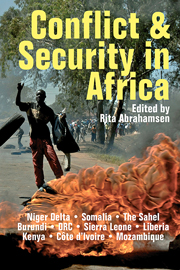Book contents
- Frontmatter
- Contents
- Preface
- Notes on Contributors
- Permissions
- 1 Introduction: Conflict & Security in Africa
- Section One Global Economies, State Collapse & Conflicts
- Section Two Global Security Governance
- 7 Somalia: ‘They Created a Desert & Called it Peace(building)’
- 8 The Burundi Peace Negotiations: An African Experience of Peace-Making
- 9 Blair's Africa: The Politics of Securitisation & Fear
- 10 Abductions, Kidnappings & Killings in the Sahel & the Sahara
- Section Three Cultures of Conflict & Insecurity
- Index
8 - The Burundi Peace Negotiations: An African Experience of Peace-Making
from Section Two - Global Security Governance
Published online by Cambridge University Press: 05 October 2013
- Frontmatter
- Contents
- Preface
- Notes on Contributors
- Permissions
- 1 Introduction: Conflict & Security in Africa
- Section One Global Economies, State Collapse & Conflicts
- Section Two Global Security Governance
- 7 Somalia: ‘They Created a Desert & Called it Peace(building)’
- 8 The Burundi Peace Negotiations: An African Experience of Peace-Making
- 9 Blair's Africa: The Politics of Securitisation & Fear
- 10 Abductions, Kidnappings & Killings in the Sahel & the Sahara
- Section Three Cultures of Conflict & Insecurity
- Index
Summary
In August 2005, the former rebel leader, Pierre Nkurunziza, was installed as the President of a newly-elected Hutu majority government in the central African state of Burundi. This marked the culmination of almost nine years of a formal peace process that followed a trajectory of peace negotiations, peace and ceasefire agreements, a transitional government and democratic elections (Irinnews.org, 2002a; b; Reyntjens 2005). Yet, it is an uneasy peace as ceasefire agreements were not reached with all warring factions and low-intensity violence and a culture of impunity pervade Burundi society.
Since independence from Belgian colonial rule in 1962, Burundi has been highly unstable, with six governments between 1962 and 1966, the abolition of the monarchy (1966), four successful coups d'état (1965, 1976, 1987 and 1994), and the assassination of its first democratically-elected President, Melchoir Ndadaye, in October 1993. Like their neighbours in Rwanda, the people of Burundi have been subjected to episodes of genocidal violence; an estimated 200,000 people were killed in 1972 and a further 20,000 in August 1988, and since Ndadaye's assassination in 1993, warfare waged by the military and government-backed militias against rebel groups and their supporters has killed some 200,000 people and forced over 350,000 into exile (ICG 1998; Arusha Peace and Reconciliation Agreement for Burundi 2000).
- Type
- Chapter
- Information
- Conflict and Security in Africa , pp. 108 - 126Publisher: Boydell & BrewerPrint publication year: 2013

